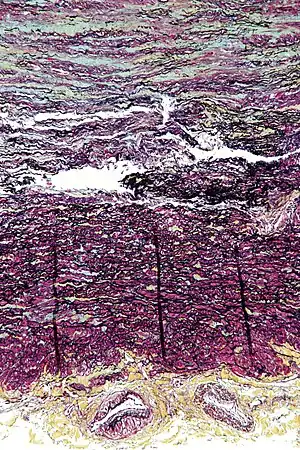Familial thoracic aortic aneurysm
| Familial thoracic aortic aneurysm | |
|---|---|
| Other names: Familial aortic dissection, cystic medial necrosis of aorta[1] | |
 | |
| Micrograph showing cystic medial degeneration, the histologic correlate of familial thoracic aortic aneurysms. The image shows abundant basophilic ground substance in the tunica media (blue at top of image) and disruption of the elastic fibers. The tunica adventitia (yellow at bottom of image) with vaso vasorum is also seen. Movat's stain. | |
Familial thoracic aortic aneurysm is an autosomal dominant[1] disorder of large arteries.
There is an association between familial thoracic aortic aneurysm and Marfan syndrome as well as other hereditary connective tissue disorders.
Signs and symptoms
A degenerative breakdown of collagen, elastin, and smooth muscle caused by aging contributes to weakening of the wall of the artery.[2]
In the aorta, this can result in the formation of a fusiform aneurysm. There is also increased risk of aortic dissection.
Genetics
Types include:
| Type | OMIM | Gene | Locus |
|---|---|---|---|
| AAT1 | 607086 | 11q23.3-q24 | |
| AAT4 | 132900 | MYH11 | 16p |
| AAT6 | 611788 | ACTA2 | 10q |
Diagnosis

The diagnosis of this condition,Familial thoracic aortic aneurysm, is done via the following:[3]
- Genetic test
- Medical history
- Clinical presentation
- Lab test
Treatment
In terms of management of this condition, is based on the following: [4]
- Symptoms presented
- Medications (to reduce stress on aorta)
- Aorta surgery
Terminology
It is sometimes called "Erdheim cystic medial necrosis of aorta", after Jakob Erdheim.[5][6]
The term "cystic medial degeneration" is sometimes used instead of "cystic medial necrosis", because necrosis is not always found.
References
- 1 2 Online Mendelian Inheritance in Man (OMIM): 607086
- ↑ Wiesenfarth, John, http://www.emedicine.com/emerg/topic28.htm Archived 2020-01-10 at the Wayback Machine, October 4, 2005
- ↑ "Familial thoracic aortic aneurysm and aortic dissection | Genetic and Rare Diseases Information Center (GARD) – an NCATS Program". rarediseases.info.nih.gov. Archived from the original on 17 October 2020. Retrieved 13 November 2021.
- ↑ "Familial thoracic aortic aneurysm and aortic dissection". NORD (National Organization for Rare Disorders). Archived from the original on 15 August 2021. Retrieved 13 November 2021.
- ↑ synd/2409 at Who Named It?
- ↑ J. Erdheim. Medionecrosis aortae idiopathica (cystica). Archiv für pathologische Anatomie und Physiologie und für klinische Medizin, 1929, 273: 454-479.
External links
| Classification | |
|---|---|
| External resources |
- GeneReview/NCBI/NIH/UW entry on Thoracic Aortic Aneurysms and Aortic Dissections Archived 2009-09-27 at the Wayback Machine